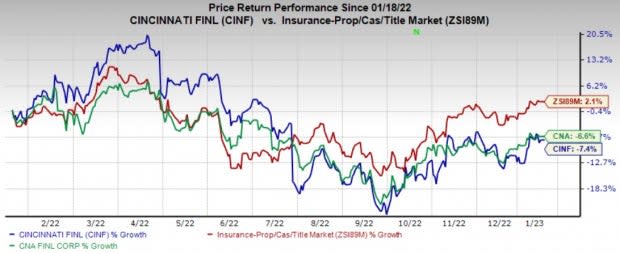CINF or CNA: Which P&C Insurance Stock is Better Positioned?
The Zacks Property and Casualty Insurance industry is likely to benefit from improved pricing, an increase in interest rate, exposure growth, prudent underwriting and a solid capital position. These poise property and casualty insurers well amid a volatile market.
The industry has risen 2.1% in the past year against the Zacks S&P 500 composite’s decline of 14.1% and the Finance sector’s 10.8% fall.

Image Source: Zacks Investment Research
Here we focus on two property and casualty insurers, namely Cincinnati Financial Corporation CINF and CNA Financial Corporation CNA.
Cincinnati Financial, with a market capitalization of $17.1 billion, provides property casualty insurance products in the United States. CNA Financial, with a market capitalization of $11.7 billion, provides commercial property and casualty insurance products primarily in the United States. Both insurers carry a Zacks Rank #3 (Hold). You can see the complete list of today’s Zacks #1 Rank (Strong Buy) stocks here.
Per Global Insurance Market Index released by Marsh, global commercial insurance prices increased 6% in the third quarter of 2022. It marked the 20th consecutive quarter of price increases. Per the Swiss Re Institute, the insurance industry is expected to generate premium growth of 2.1% on average over the next two years. An expanded distribution, operational strength, higher retention, strong renewal, price increases and a solid balance sheet are likely to help insurers retain momentum.
Per Deloitte Insights, gross premiums are estimated to increase about six-fold to $722 billion by 2030. Per a report from the Deloitte Center for Financial Services, global life insurance premium is estimated to increase 1.9% in 2023.
The insurance industry is likely to grow on the back of higher new business premiums, growth in the line of business and expanding international business.
The P&C insurers remain exposed to catastrophe loss from natural disasters and weather-related events, which induce volatility in their underwriting results. Per Swiss Re Institute, natural catastrophe activity resulted in insured losses of $115 billion in 2022, which is higher than the 10-year average of $81 billion. Swiss Re estimated Hurricane Ian to be the most expensive one, with estimated preliminary insured losses of $50 billion to $65 billion. Nevertheless, prudent underwriting, continued increases in pricing, reinsurance programs and favorable reserve development should help insurers withstand the blows.
Insurance companies are the direct beneficiaries of growing interest rates. Seven rate hikes have been implemented by the Fed in 2022 to control persistent inflation. In the last monetary policy meeting of 2022, the Fed raised interest rates by 50 bps to the range of 4.25 to 4.5%.
Riding on operational efficiency resulting in a solid capital position, insurers should continue to engage in strategic mergers and acquisitions to sharpen their competitive edge, build on a niche, expand globally, diversify their portfolio and deploy capital to enhance shareholder value. Per a report from the Deloitte Center for Financial Services, the insurance industry witnessed 427 completed deals in the first half of 2022, which increased 16% year over year.
The insurers have increased investment in emerging technologies in a bid to drive efficiency, enhance cybersecurity, upgrade claims systems as well as expand automation capabilities across the organization. The industry is witnessing greater use of technology like blockchain, AI, advanced analytics, telematics, cloud computing, the emergence of insurtech and robotic process automation to expedite business operations and save costs.
Now let’s take a look at how CINF and CNA are poised.
Price Performance
CNA Financial has lost 6.6% in the past year compared to the industry’s increase of 2.1%. Cincinnati Financial shares have declined 7.4% in the said time frame.

Image Source: Zacks Investment Research
Return on Equity (ROE)
CNA Financial, with a return on equity (ROE) of 10.08%, exceeds Cincinnati Financial’s ROE of 7% and the industry average of 6.7%.

Image Source: Zacks Investment Research
Valuation
The price-to-book value is the best multiple used for valuing insurers. Compared with Cincinnati Financial’s P/B ratio of 1.81, CNA Financial is cheaper, with a reading of 1.45. The P&C insurance industry’s P/B ratio is 1.57.

Image Source: Zacks Investment Research
Debt-to-Capital
CNA Financial’s debt-to-capital ratio of 25.5 is higher than Cincinnati Financial’s reading of 8.6 as well as the industry average of 20.5. Therefore, Cincinnati Financial has an advantage over CNA Financial on this front.
Earnings Surprise History
Cincinnati Financial outpaced expectations in five of the last six reported quarters. CNA Financial surpassed estimates in four of the last six reported quarters.
Growth Projection
Earnings growth and stock price gains often indicate a company’s strong prospects.
The Zacks Consensus Estimate for CNA Financial’s 2023 earnings implies year-over-year increase of 12.5%, while that of Cincinnati Financial suggests year-over-year increase of 7.1%.
Therefore, CNA Financial is at an advantage on this front.
Combined Ratio
CNA Financial’s combined ratio was 93 in the first nine months of 2022, whereas that of Cincinnati Financial was 99.2% in the said time frame. Thus, the combined ratio of CNA was better than CINF.
Dividend Yield
CNA Financial’s dividend yield of 3.7% betters Cincinnati Financial’s dividend yield of 2.5%. Thus, CNA has an advantage over CINF on this front.
To Conclude
Our comparative analysis shows that CNA Financial is better positioned than Cincinnati Financial with respect to price performance, dividend yield, return on equity, valuation, combined ratio and growth projection. Meanwhile, Cincinnati Financial scores higher in terms of leverage and earnings surprise history. With the scale significantly tilted toward CNA, the stock appears to be better poised.
Want the latest recommendations from Zacks Investment Research? Today, you can download 7 Best Stocks for the Next 30 Days. Click to get this free report
Cincinnati Financial Corporation (CINF) : Free Stock Analysis Report
CNA Financial Corporation (CNA) : Free Stock Analysis Report

 Yahoo Finance
Yahoo Finance 